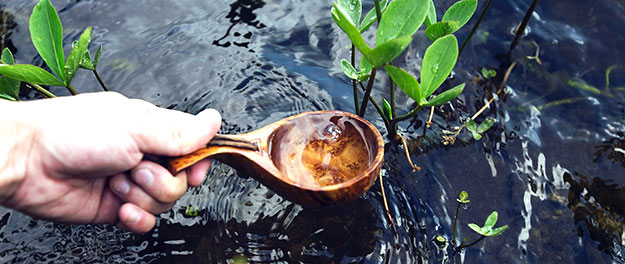The first thing you should do if you’re stranded in the wild is find a source of drinkable water. The most obvious sources are streams, rivers and lakes. Animals always know where the water is, so be on the lookout for wildlife or animal tracks. Lush green vegetation is also a sign that water is nearby. Swarming insects may be a hassle, but they also signal that a water source isn’t far away.
Bird flight paths in the morning or evening can point you in the right direction. Stay on the move until you find a water source. When you pause to rest, use your ears — rivers can be heard in the quiet woods from great distances. Remember that water always flows downhill, so low-lying areas and valleys are a good bet.
If you find a muddy area, there may be groundwater available. Dig a hole about a foot deep and one foot in diameter and wait. You may be surprised to find that the hole is soon filled with water. This groundwater will be muddy, but straining it through some cloth will clean it up, and it will get you by in the short term. It’s crucial to remember that any time you drink found water without purifying it, you’re taking a risk.
Rainwater in most rural areas can usually be consumed without risk of disease or illness. If it rains, use any and all containers you can get your hands on to collect it. If you have a poncho or can find some plastic sheeting, spread it out and tie the corners to trees a few feet off the ground. Find a container and tie the poncho on a slant with a slight sag to allow the rain to collect and drain. If you can’t find a container, tie it level on all four corners and give it even more of a sag — it will serve as a makeshift water bag. If the rainwater tastes a little different, it’s because it lacks certain minerals that are found in groundwater or streams.
If you’re near snow and ice, melt it and drink the water. Don’t ever eat it frozen — it’ll reduce your body temperature and lead to dehydration. The melted snow and ice should also be purified if you have the means.
Heavy dew can also provide potable water. Before the sun rises, tie some absorbent cloth around your shins and take a walk through some high grass. You may be able to soak up enough water for an early morning drink. Vegetation helps supply you with water as well. Fruits, coconuts, cacti, vines, palm trees and bamboo can be good sources of liquid sustenance. Bend the top of a green bamboo tree down about a foot off the ground and tie it off. Cut a few inches off the tip, put a container underneath and leave it overnight. The next day, you should have a nice amount of clear, drinkable water.
No matter how dire your circumstances, you should never drink the following:
- Blood
- Urine
- Fish juices
- Salt water
- Alcohol
- Fresh sea ice
Fresh sea ice is milky or grey, has sharp edges, does not break easily and is extremely salty. Older sea ice is usually salt-free, and you can spot it by its blue or black tint, rounded edges and breakability. As with snow, you should melt old sea ice and ideally purify it before you drink it.
Source: https://adventure.howstuffworks.com/
Dear User/Visitor! Please, answer on our questions: tick off one of the positions – your answer will make us able to improve our site and make it more interesting and useful!


